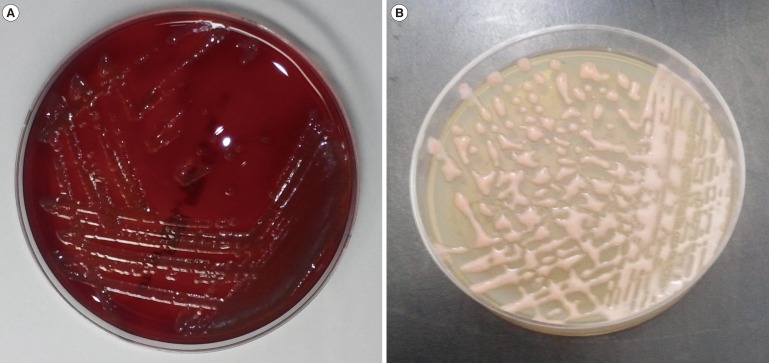Ann Lab Med.
2016 Jul;36(4):367-370. 10.3343/alm.2016.36.4.367.
Two Cases of Bacteremia Due to Roseomonas mucosa
- Affiliations
-
- 1Department of Laboratory Medicine, Yeungnam University School of Medicine, Daegu, Korea.
- 2Department of Laboratory Medicine, Kyungpook National University Hospital, Daegu, Korea. leewk@knu.ac.kr
- 3Department of Clinical Pathology, Kyungpook National University School of Medicine, Daegu, Korea.
- KMID: 2373558
- DOI: http://doi.org/10.3343/alm.2016.36.4.367
Abstract
- Roseomonas is a genus of pink-pigmented nonfermentative bacilli. These slow-growing, gram-negative cocobacilli form pink-colored colonies on sheep blood agar. They differ from other pink-pigmented nonfermenters, including Methylobacterium, in morphology, biochemical characteristics, and DNA sequence. Roseomonas strains are rarely isolated in clinical laboratories; therefore, we report two cases in order to improve our ability to identify these pathogens. We isolated two strains of Roseomonas mucosa from the venous blood cultures of two patients, an 84-yr-old woman with common bile duct obstruction and a 17-yr-old male with acute myeloid leukemia who had an indwelling central-venous catheter for chemotherapy. The isolated strains were confirmed as R. mucosa by 16S rRNA sequencing.
Figure
Reference
-
1. Rihs JD, Brenner DJ, Weaver RE, Steigerwalt AG, Hollis DG, Yu VL. Roseomonas, a new genus associated with bacteremia and other human infections. J Clin Microbiol. 1993; 31:3275–3283. PMID: 8308122.2. Dé I, Rolston KV, Han XY. Clinical significance of Roseomonas species isolated from catheter and blood samples: analysis of 36 cases in patients with cancer. Clin Infect Dis. 2004; 38:1579–1584. PMID: 15156446.3. Han XY, Pham AS, Tarrand JJ, Rolston KV, Helsel LO, Levett PN. Bacteriologic characterization of 36 strains of Roseomonas species and proposal of Roseomonas mucosa sp nov and Roseomonas gilardii subsp rosea subsp nov. Am J Clin Pathol. 2003; 120:256–264. PMID: 12931556.4. Struthers M, Wong J, Janda JM. An initial appraisal of the clinical significance of Roseomonas species associated with human infections. Clin Infect Dis. 1996; 23:729–733. PMID: 8909835.5. Alcalá L, Vasallo FJ, Cercenado E, García-Garrote F, Rodríguez-Créixems M, Bouza E. Catheter-related bacteremia due to Roseomonas gilardii sp. nov. J Clin Microbiol. 1997; 35:2712. PMID: 9316945.6. Fanella S, Schantz D, Karlowsky J, Rubinstein E. Septic arthritis due to Roseomonas gilardii in an immunocompetent adolescent. J Med Microbiol. 2009; 58:1514–1516. PMID: 19574413.7. Wang CM, Lai CC, Tan CK, Huang YC, Chung KP, Lee MR, et al. Clinical characteristics of infections caused by Roseomonas species and antimicrobial susceptibilities of the isolates. Diagn Microbiol Infect Dis. 2012; 72:199–203. PMID: 22209515.8. Sandoe JA, Malnick H, Loudon KW. A case of peritonitis caused by Roseomonas gilardii in a patient undergoing continuous ambulatory peritoneal dialysis. J Clin Microbiol. 1997; 35:2150–2152. PMID: 9230401.9. Bibashi E, Sofianou D, Kontopoulou K, Mitsopoulos E, Kokolina E. Peritonitis due to Roseomonas fauriae in a patient undergoing continuous ambulatory peritoneal dialysis. J Clin Microbiol. 2000; 38:456–457. PMID: 10618142.10. McLean TW, Rouster-Stevens K, Woods CR, Shetty AK. Catheter-related bacteremia due to Roseomonas species in pediatric hematology/oncology patients. Pediatr Blood Cancer. 2006; 46:514–516. PMID: 15782406.11. Elshibly S, Xu J, McClurg RB, Rooney PJ, Millar BC, Alexander HD, et al. Central line-related bacteremia due to Roseomonas mucosa in a patient with diffuse large B-cell non-Hodgkins' lymphoma. Leuk Lymphoma. 2005; 46:611–614. PMID: 16019492.12. Christakis GB, Perlorentzou S, Alexaki P, Megalakaki A, Zarkadis IK. Central line-related bacteraemia due to Roseomonas mucosa in a neutropenic patient with acute myeloid leukaemia in Piraeus, Greece. J Med Microbiol. 2006; 55:1153–1156. PMID: 16849738.13. Salar A, Carratalà J, Zurita A, Gonzàlez-Barca E, Grañena A. Bacteremia caused by CDC group IV c-2 in a patient with acute leukemia. Haematologica. 1998; 83:670–672. PMID: 9718879.14. Subudhi CP, Adedeji A, Kaufmann ME, Lucas GS, Kerr JR. Fatal Roseomonas gilardii bacteremia in a patient with refractory blast crisis of chronic myeloid leukemia. Clin Microbiol Infect. 2001; 7:573–575. PMID: 11683803.15. Tsai SF, Chen CH, Shu KH, Wu MJ. Peritonitis caused by Roseomonas in a patient undergoing automated peritoneal dialysis: case report and literature review. Intern Med. 2012; 51:1721–1724. PMID: 22790133.16. Ece G, Ruksen M, Akay A. Case report: cranioplasty infection due to gilardii at a university hospital in Turkey. Pan Afr Med J. 2013; 14:162. PMID: 23819004.
Article17. Nolan JS, Waites KB. Nosocomial ventriculitis due to Roseomonas gilardii complicating subarachnoid haemorrhage. J Infect. 2005; 50:244–251. PMID: 15780421.18. Shokar NK, Shokar GS, Islam J, Cass AR. Roseomonas gilardii infection: case report and review. J Clin Microbiol. 2002; 40:4789–4791. PMID: 12454198.19. Bard JD, Deville JG, Summanen PH, Lewinski MA. Roseomonas mucosa isolated from bloodstream of pediatric patient. J Clin Microbiol. 2010; 48:3027–3029. PMID: 20534804.
- Full Text Links
- Actions
-
Cited
- CITED
-
- Close
- Share
- Similar articles
-
- Infectious Spondylitis with Bacteremia Caused by Roseomonas mucosa in an Immunocompetent Patient
- A Case of Roseomonas Infection in Korea
- First Report of Roseomonas aerofrigidensis Isolated from the Peritoneal Fluid of a Gastric Cancer Patient
- A Case of Shigella sonnei Bacteremia in an Adult
- Eggerthella Lenta Bacteremia after Appendectomy in a Healthy Patient


